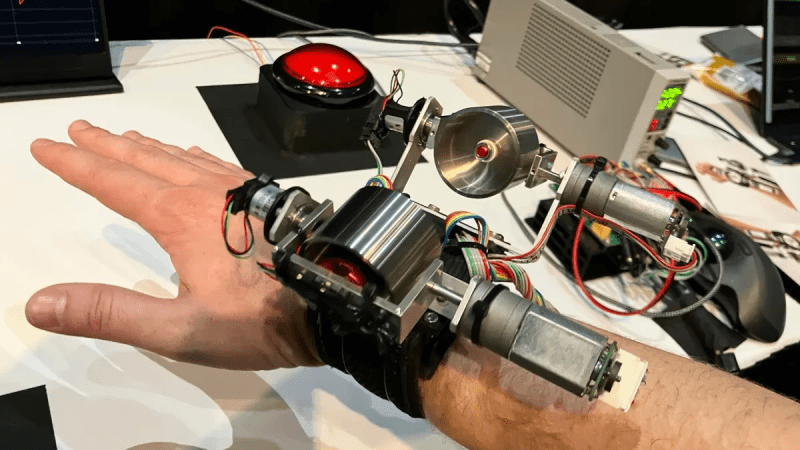[Devin Coldewey] shared his experiences with some of the more unusual VR concepts on display at SIGGRAPH 2023. Some of these ideas are pretty interesting in their own right, and even if they aren’t going to actually become commercial products they give some insight into the kinds of problems that are being worked on. Read on to see if anything sparks ideas of your own.
In the area of haptics and physical feedback, Sony shared research prototypes that look like short batons in which are hidden movable weights. These weights can shift up or down on demand, altering their center of gravity. [Devin] states that these units had a mild effect on their own, but when combined with VR visuals the result was impressive. There’s a video demonstration of how they work.
A more unusual take on physical feedback was a wrist-mounted device with two flywheels attached to it. This device — dubbed SomatoShift — is shown in the header image above. They work exactly like the reaction wheels on satellites. By turning these spinning wheels, different forces can be felt by the wearer. The prototype looks cumbersome, but the forces exerted by the system can be controlled with very high accuracy.
JumpMod is something readers may remember from earlier this year, and consists of a 2 kg weight worn as a backpack. By moving the weight upward or downward at precise times, the wearer can feel the illusion of a higher (or lower) than normal jump.

VR headset research prototypes from Meta made an appearance, including a light field passthrough headset (Flamera prototype) that has a fascinating external lens array and a varifocal display (named Butterscotch) which may remind regular readers of prototypes showcased last year.
Let us take a moment to bring up some other experimental work that, while not present at SIGGRAPH, is nevertheless good idea fodder. Finger Haptics uses electrical signals to simulate feeling in the palm side of the hand and fingers, which is notable because the hand is left free to hold and manipulate objects normally. Nothing is actually worn or mounted on the palm-side of the hands or fingers.
Another approach is from the company Tactical Haptics which created a grip with sliding panels that simulate feelings of feedback via a shearing kind of movement (PDF) which seems like an approach particularly suited to some DIY.
Finally, one of our favorite DIY projects is Real Virtual Magic, which uses a small off-the-shelf EEG unit to make magic’s effectiveness in Skyrim VR depend on the wearer’s actual state of mind.
Know of any other interesting, useful, or just plain bizarre VR interface ideas? Share them in the comments, or use the tips line. We’d love to hear about them.
















https://hackaday.io/project/190611-enhancer-mask-lite
The more of these separate tricks people develop, the more delusional the “holodeck” aspiration for VR looks. To make an experience /indistinguishable/ from reality, you’d have to be encased in a shipping containerful of machinery that cost millions and still couldn’t fake key things (like eating and gravity).
But then, this is a weird goal to pursue in the first place. When people were developing painting or movies or radio, the criterion was never “can you tell if it’s artificial or not?” Even the best 70mm movie print is obviously artifical; in fact that’s kind of the point, because artificial experiences can go beyond what you can experience in real life. So maybe the question for VR should be, how do you make this into a practical medium that /adds to/ reality?
That said, even if these inventions are a dead end in terms of Lawnmower Man-style VR, some of them could lead to interesting applications of their own, so exploration is always good.
We don’t do technology to do easy things. There were people looking at room sized computers saying they will never scale beyond military applications. Boy they were wrong. There were people looking at early gas engines saying that the issues of compression and synchronization would never be doable at scale.
Yeah, you cannot live in another world, no one thinks that. But some of those technologies will make it to container sized environments, train people for hazardous jobs, help do therapy through different environments. Some of those crazy expensive things will make it to consumer hardware, and make the tech 1 or 2% better. But those add up.
The people who make things often have no rational reasons to make them, and are very often separate from the people who take those things and apply them to real applications.
>Boy they were wrong.
Not really. Those computers didn’t scale beyond military applications. Other computers did, but you can’t blame the people for not knowing the future. Hindsight 20/20.
There seems to be a common bias where people will look at any technology, and assume that because the technology in the past got better, this particular technology must as well.
They’re forgetting that most inventions and technologies simply failed because nobody could come up with the keystone technology or solve the fundamental problems that kept them from being useful, or something better came along instead.
Could the common observer in the 1930’s have predicted transistors? What if the transistor had never been invented?
I think there’s an ableism that underpins VR romanticism. VR is currently only working for those where it does not impede other optical instruments (glasses namely). The current gen VR hardware could have a negative impact on normal users eyesight as well, since separating each eye from the other could lead to eye strain and eventual damage.
Yes, verily, we must level all mountains and fill in all oceans with their silt
They bring up an actually good point regarding taking into consideration differently-abled persons when developing tech. Obviously ALL edge-cases can’t be covered (like your straw-man argues against), but bringing them into the conversation is a valid and necessary step to prevent excluding groups unnecessarily.
Eh enough people are learning to sniff out the specific language you people use and have enough experience to know that you people never stop, you build entrenched bureaucracies in every organization whose entire job is to find more of these groups to cater to so that their work is never done. Your strategy isn’t working as well as it used to, and your bourgeois morality fads are running out of steam. It’s not just about people with glasses and you damn well know it
I feel like there’s a fair bit of middle ground between ‘Red of Tooth and Claw’ and ‘Harrison Bergeron’
You can always hook up one of Musk’s brain interfaces instead; to fake the experiences.
(I’ll pass on that one though)
And it would be typical if all the inflated ideas/promises boiled down to becoming a VR game controller.
The idea that you could hijack someone’s brain into a virtual reality is just as far fetched. It would imply somehow taking over all their senses perfectly and completely, so the brain doesn’t know that it’s not actually receiving signals from the eyes, ears, etc. That sounds like a much harder task. You’d have to pull off a man-in-the-middle attack on their spinal cord and optical nerves, cochleas, etc. and perfectly replicate the signals the person has learned as they were growing up.
If you just hook up some wires to a tiny bit of your cortex and start tickling it with electricity, that’s the functional equivalent of trying to communicate with someone by poking a finger at their left elbow, or whatever that part of the brain happens to associate with. You could with time learn to associate the sensation with on-screen visuals or sounds etc. but it’s always going to be a “different sense” like gaining a third eye, rather than full immersion. The original two eyes are still seeing whatever happens in front of you.
For the purposes of AR that’s what one wants without a complete takeover.
In case you’re wondering what’s that neat power supply on the top picture looks like it’s one of matsusada’s R4K-80 series
Vlad the Impaler approaches with a new twist on an old ideea.